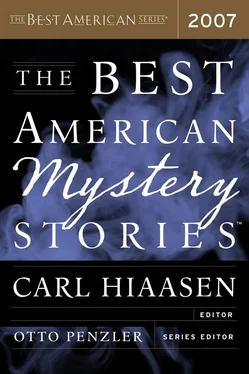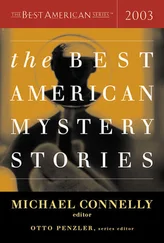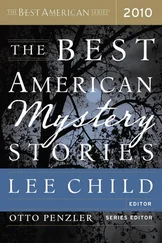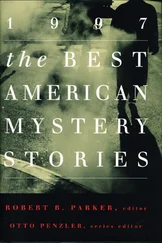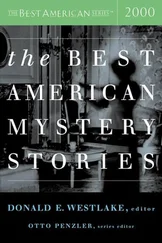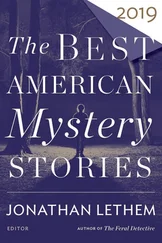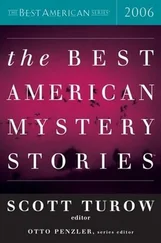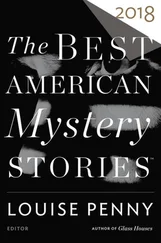This is Laura Lippman’s third appearance in The Best American Mystery Stories. A former newspaper reporter, she is the author of nine novels in the award-winning Tess Monaghan series and three standalone crime novels. She lives in Baltimore.
• The character in “One True Love” began rattling around in my brain in 2001; I remember the date because it was only two months after 9/11 and I was at a conference in Washington, D.C., where I kept trying to explain the concept to anyone who would listen. “Wouldn’t prostitution, under certain conditions, be a great job for a single mother? Wouldn’t it be funny if a prostitute lived in a pricey suburb and turned out to be its most principled resident?” Everyone thought I was crazy. Then Desperate House wives showed up on ABC, and people thought I was merely derivative. It was only when Harlan Coben invited me to write a story for Death Do Us Part that I saw how melancholy the story would have to be. But I don’t think I’m done with Heloise, not by a long shot.
David Means’sstories have appeared in The New Yorker, Harper’s, and Zoetrope, and in numerous anthologies, including The Best American Short Stories, The Best American Mystery Stories, and The O. Henry Prize Stories. He is the author of three short story collections, including the award-winning Assorted Fire Events (just published in a new edition by Harper/Perennial) and The Secret Goldfish. He teaches at Vassar College.
• It’s hard — for me at least — to tweeze apart a story and to find exact links to specific points of inspiration, hut I can say that on the way through Cleveland — at least once a year for the past few years — I’ve stayed at the Holiday Inn along the shore of Lake Erie, not far from the Rock & Roll Hall of Fame. Out in front of the hotel, near the entrance to the parking lot, is a plaque commemorating the first water intake pipe — not far offshore — for the Cleveland water supply. Each year, I stood and looked out at the lake and thought to myself: when the time’s right, I’ll make use of this spot in some kind of story. Something struck me about the idea — more than the actual, physical reality — of a large pipe, not far from shore, sucking in the water supply for an entire city. That image sat in my mind and fermented until, one day, after I read a devastating essay by Peter Landesman (in Best American Crime Writing 200 5) on sex trafficking, my imagination took over, and, drawing from a long personal history in the Midwest, I began writing a story that is, in part, about a young woman caught in a different kind of torrential flow, one of unforgiving, raging violence.
Kent Meyersis the author of four books. The River Warren and Eight in the Crossing were New York Times Notable Books, and The Work of Wolves won a Mountain and Plains Booksellers Association Award. Meyers is a writer-in-residence at Black Hills State University in Spearfish, South Dakota.
• Shane Valen began as a minor character in The Work of Wolves, whose sole role was to move a particular piece of plot along. During the third draft of the book, I had him driving his pickup across a hay field toward a major character. Carson Fieldling, when I became interested in Shane himself. I gave in to my interest and to the rhythms of language and suddenly had seven or eight pages describing Shane’s family background, his poaching, his father’s trip to Minneapolis, the shooting of the wind-vane rooster, and even Sarah’s life after she abandoned Shane and Rodney. None of this made it into the final draft of The Works of Wolves, but I decided to try to salvage it as a short story. Several versions of this story are told from Sarah’s point of view and are focused on her relationship with her father instead of her husband and son. In fact, the story was originally titled “The Patron Saint of Travelers,” in reference to duplicate St. Christopher medals Sarah and her father kept in their cars. The story never quite worked, however, until I decided to make it part of a novel-in-stories and tell it in Greggy Longwell’s voice. Greggy quotes one of Shane’s letters referring to the murder of a girl. This murder — of Hayley Jo Zimmerman — ties the various stories in the collection together. I suspect it was the overall mood of the collection — and of course Greggy’s voice — that brought out the qualities of “mystery” in the story: the attempts to understand events and the feeling that the real mystery lies not in the events themselves but in the paradoxes of the human heart and mind.
Joyce Carol Oatesis the author most recently of The Museum of Dr. Moses, a gathering of mystery-suspense stories, and the novel The Gravedigger’s Daughter. She is the 2005 recipient of the Prix Famina for her novel The Falls and the 2006 recipient of the Chicago Tribune Lifetime Achievement Award for Literary Achievement.
• Like most of my fiction, “Meadowlands” springs from both personal experience and invention. My idea of setting a story at the famed Meadowlands racetrack springs from an intense, almost unbearably suspenseful visit to the track in the late 1980s, when my husband and I watched a beautiful Standardbred mare (Impish Lobell — so named for the Lobell Horse Farm in New Jersey), whom we part owned, win her first race. My writing is nearly always generated by a powerful sense of place, and so the Meadowlands stables, the track, the prerace suspense among the horse owners and spectators, provided the impetus for a story that came to be written only years later, with characters who both are, but are not, “real”: a story of missed love, winning and losing, heartbreak.
Jason Ockerthas won several National Fiction Awards and is the author of the short-story collection Rabbit Punches. His stories have appeared in many journals, including Oxford American, Mid-American Review, Indiana Review, Alaska Quarterly Review, and McSweeney’s. He teaches at Coastal Carolina University.
• The very first idea I had for this story was to create two men (one in handcuffs) who were telling lies to each other. Eventually, I wanted the reader to understand that the cuffed man was the victim while the free man was the villain. But as I began to investigate these characters I quickly realized that my initial concept was too reductive. After spending more and more time with Therm and Cole, I started to hammer out their sensibilities and concerns. The intangibles of these characters led me to Jakob’s story and that sense of menace we often overlook when we romanticize childhood as a time of uncomplicated innocence. Perhaps the hardest part of writing this story was letting Jakob disappear.
Ridley Pearsonis the author of twenty-three crime/suspense novels, and the coauthor, with Dave Barry, of a trilogy of award-winning books for young readers exploring the origins of Peter Pan: Peter and the Starcatchers. He presently divides his time writing both crime and young adult novels. In 1991, Ridley was the first American awarded the Raymond Chandler Fulbright Fellowship in Detective Fiction Writing at Wadham College in Oxford. England.
• When Harlan Coben wrote me, asking if I would contribute to a short-story anthology, I agreed without hesitation. You don’t say no to Harlan. My wife had had an edgy experience while running in a park near where we live — the same male runner appeared by her side several days in a row — and I used this experience to leapfrog into writing “Queeny.” I’ve been basing my novels on extensive research for years, but this took it up a notch, as the threat to my wife fell palpable. There’s a voice at work in “Queeny” that is the most comfortable one in which I’ve ever written. I’ve spoken with my adult novel editor, Dan Conaway, about exploring this voice in a larger work. That’s still on hold, but it’s something I look forward to. In all the books I’ve written (over some twenty-five years now), I’ve never had a new voice just fall on the page as it did in “Queeny.” It was a gift, I think, that resulted from a total lack of pressure — I was doing Harlan a favor. And now, as it turns out, he did me one. Way of the world.
Читать дальше
